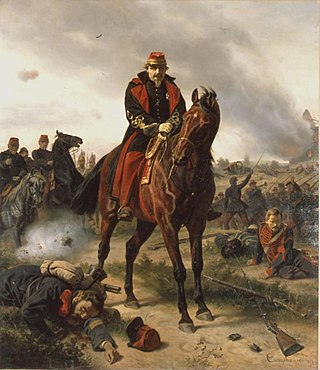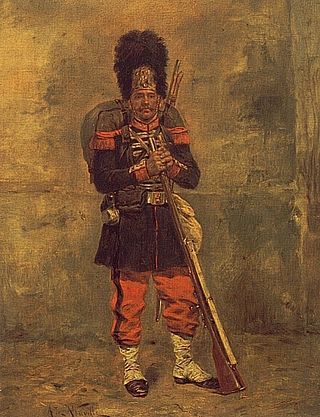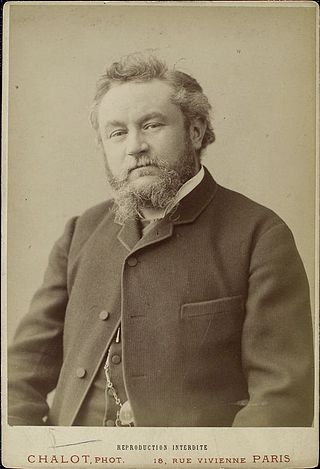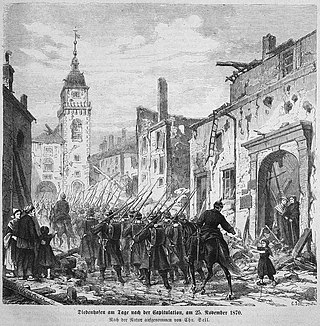
The Franco-Prussian War or Franco-German War, often referred to in France as the War of 1870, was a conflict between the Second French Empire and the North German Confederation led by the Kingdom of Prussia. Lasting from 19 July 1870 to 28 January 1871, the conflict was caused primarily by France's determination to reassert its dominant position in continental Europe, which appeared in question following the decisive Prussian victory over Austria in 1866. According to some historians, Prussian chancellor Otto von Bismarck deliberately provoked the French into declaring war on Prussia in order to induce four independent southern German states—Baden, Württemberg, Bavaria and Hesse-Darmstadt—to join the North German Confederation; other historians contend that Bismarck exploited the circumstances as they unfolded. All agree that Bismarck recognized the potential for new German alliances, given the situation as a whole.

The Battle of Wörth, also known as the Battle of Reichshoffen or as the Battle of Frœschwiller, refers to the second battle of Wörth, which took place on 6 August 1870 in the opening stages of the Franco-Prussian War. In the second battle, troops from Germany commanded by Crown Prince Frederick William and directed by his chief of staff, General Leonhard Graf von Blumenthal, defeated the French under Marshal MacMahon near the village of Wœrth in Alsace, on the Sauer River, 10 kilometres (6.2 mi) north of Haguenau.

The Battle of Sedan was fought during the Franco-Prussian War from 1 to 2 September 1870. Resulting in the capture of Emperor Napoleon III and over a hundred thousand troops, it effectively decided the war in favour of Prussia and its allies, though fighting continued under a new French government.

Cuirassiers were cavalry equipped with a cuirass, sword, and pistols. Cuirassiers first appeared in mid-to-late 16th century Europe as a result of armoured cavalry, such as men-at-arms and demi-lancers discarding their lances and adopting pistols as their primary weapon. In the later part of the 17th century, the cuirassier lost his limb armour and subsequently wore only the cuirass, and sometimes a helmet. By this time, the sword or sabre had become his primary weapon, with pistols relegated to a secondary function.

The negroni is a cocktail, made of equal parts gin, vermouth rosso, and Campari, generally served on the rocks, and commonly garnished with an orange slice or orange peel. It is considered an apéritif.

The 3rd Cuirassier Regiment was a cavalry regiment of the French Army, later reequipped as an armored regiment.

The Imperial Guard of Napoleon III was a military corps in the French Army formed by Napoleon III as a re-establishment of his uncle Napoleon I's Imperial Guard, with an updated version of the original uniforms and almost the same privileges.

Rogliano is a commune in the French department of Haute-Corse, Corsica.
Negroni is an Italian/Corsican surname. Notable people with the surname include:
Events from the year 1870 in France.

Henri Jules Bataille was a nineteenth-century French soldier. He rose to général de division of infantry, saw colonial service in Algeria, and fought in the Second Italian War of Independence and the Franco-Prussian War. He was awarded the Grand Cross of the Legion of Honour.

Charles-Albert-Marie Costa, Marquis de Beauregard was a French historian and politician. He also fought in the Franco-Prussian War. His works include a trilogy on Charles Albert of Sardinia.

Émile Bergerat was a French poet, playwright and essayist. He used the pseudonyms l'Homme masqué, Caliban and Ariel. A library in Neuilly-sur-Seine opposite his flat bears his name.

Belgium was not a belligerent in the Franco-Prussian War (1870–1871), as the country was neutral throughout the war, but was heavily influenced by the social and political effects of the conflict. An invasion of Belgian territory by either side was widely feared in 1870 and the Belgian Army was mobilised. The inadequacies which this revealed in Belgium's military and defensive preparations led to calls to reform the system of conscription and for a programme of fortification-building which would greatly influence the early phases of World War I.

Théophile Poilpot, also known as Théophile-François-Henri Poilpot, was a French panorama painter.
The Battle of Châtillon, also known as the Battle of Châtillon-sous-Bagneux, was a skirmish in the Siege of Paris between France and North German Confederation in the Franco-Prussian War, took place on 13 October 1870. This is also considered the first battle in the history of the French Third Republic. In this fierce battle – occurred at Châtillon and Sceaux, Corps V of the Prussian army under the command of Lieutenant General Infantry Hugo von Kirchbach, along with the II Corps of the Kingdom of Bavaria by the Supreme Minister infantry Jakob von Hartmann which were the forces of the army Group 3 of Prussia by Prince Friedrich Wilhelm as General command., won a victory against an attack by the XIV Corps under General Renault - of the French army under General Auguste-Alexandre Ducrot. Although some soldiers under Ducrot fought well, the majority of his army became agitated. The French were forced to flee to Paris, losing the Châtillon Plateau - a very favorable defensive position overlooking the fortresses south of Paris - to the Germans. This was a disaster for the "justice" of the French army during the war, although the French reported that they suffered only minor losses.

Jean-Jacques Alexis Uhrich, was a French général de division. He was the great uncle of Général d'armée Maurice Gamelin (1872–1958). Military governor of the city of Strasbourg in 1870, Uhrich is best known for his service during the Franco-Prussian War (1870–1871) as the commander of French forces during the Siege of Strasbourg and for surrendering the city to German forces.

The siege of Thionville was a battle of the Franco-Prussian War which occurred in Thionville of the Moselle from November 13 to November 24, 1870. The small French garrison repulsed an attempted attack on August 14. It was subjected to a blockade and then besieged from November 13. After the capitulation of Metz, on October 28, 1870, the Prussians move part of their powerful artillery to Thionville. Bombed from November 22, the square surrendered on November 24. The capture of Thionville and that of Montmédy a month later gave the Germans control of the railroad to the Picardy front.

The Battle of Artenay' also known as the Battle of Arthenay, took place during the Franco-Prussian War, on October 10, 1870, in Artenay a small town located on the road from Orléans to Paris, France which was about 10 miles north of the city of Orléans. In this fierce battle, with superior strength compared to the opponent, The I Corps of the Kingdom of Bavaria, under the command of Lieutenant General Ludwig von der Tann-Rathsamhausen, in collaboration with the 22nd Division of the XI Corps of the Kingdom of Prussia and the two cavalry divisions of the Prussian army attacked and penetrated the defense system of the army of the Loire of the young French Republic, under the control of general Joseph Edouard de la Motterouge, causing heavy losses for the French military of which many people were taken prisoner. The winning conditions Artenay were favorable enough for Von der Tann to strike Orléans, while the forces of France knocked back on Orléans forest in an agitated state. Despite this, Nièvre's Garde Mobiles and the Pontifical Legion in the French army were noted for their strong resistance, while a monk in Prussian Cavalry under the command of Prince Albrecht demonstrated his prowess in the battle at Artenay.
The Fighting at Épuisay was a military conflict of the Franco-Prussian War, it took place on 17 December 1870, in Épuisay where there was a junction of roads from Vendôme and Morée to Saint-Calais. This was a battle between the rear forces of the Armée de la Loire of the French Republic under the command of Antoine Chanzy with the German army in retreat after X Legion being defeated in the Battle of Vendôme on 16 December 1870. Under the command of General Ludwig von der Tann-Rathsamhausen, the German army captured Epuisay and captured 230 prisoners.
















